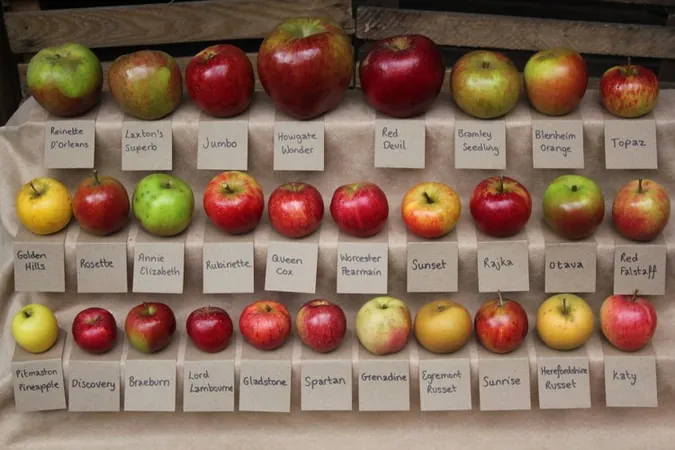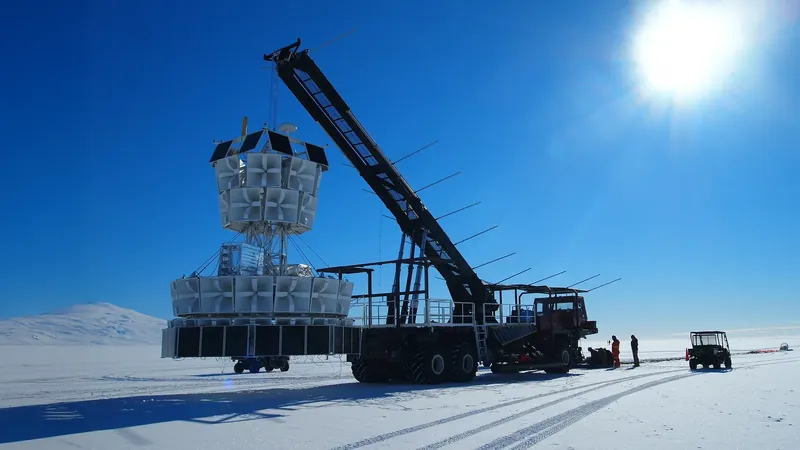
Unlocking the Apple’s 60-Million-Year Genetic Journey: What’s Next?
2025-04-24
Author: Emma
In the serene forests of the Northern Hemisphere, a captivating tale has been blossoming for nearly 60 million years. This isn't just any story—it's the revolutionary evolution of the apple, a fruit that seems simple but is anything but ordinary.
A groundbreaking new study has peeled back the layers of genetic history of apples, revealing how wild and cultivated varieties merged and adapted over eons. An international team of researchers, including noted scientists from Penn State, has created the most comprehensive genetic map of apples and their wild counterparts to date.
Mapping the Apple Family Tree
Prior to this study, scientists only skimmed the surface of the apple's complex genetic lineage. Most previous research focused solely on a few cultivated types, leaving substantial gaps in understanding the broader Malus genus. This new exploration, however, sequenced 30 high-quality genomes, including the beloved 'Golden Delicious' and 29 wild species.
Of the species studied, 20 are diploid (with two chromosome copies) while 10 are polyploid (with three or four copies). These additional gene copies likely emerged from recent hybridization events. By examining around 1,000 genes in each species, the team crafted a detailed family tree, tracing the Malus lineage back to East Asia approximately 56 million years ago.
"There are about 35 species in the Malus genus, yet the apple's grouping hasn’t been thoroughly studied until now," said Hong Ma, a biology professor at Penn State and lead researcher. "This analysis allowed us to dive deep into the genomes, unravel an apple family tree, document significant events like whole-genome duplications, and locate genes linked to crucial traits."
The Groundbreaking Power of Pan-Genomics
To better grasp how traits have evolved, the team employed pan-genomics, comparing both shared and unique genes across species. They analyzed transposons, or "jumping genes," that can shift positions within the genome.
Rather than relying on a single reference genome, the research created a genome graph that interlinks the 30 species, offering clarity on the genetic variations tied to essential traits like flavor and disease resistance. Ma stated, "This extensive approach was powerful for revealing structural variations and gene rearrangements that could be overlooked when comparing just a few genomes. For instance, we pinpointed the genome segment responsible for resistance to apple scab, a widespread fungal disease."
The Trade-Offs of Tastiness
In the pursuit of tastier apples, some hardiness may have been sacrificed. The researchers tracked a process called a selective sweep—a scenario where a beneficial trait rapidly becomes prevalent within a population. They discovered that a gene associated with cold and disease resistance may come with a bitter taste.
"In striving for exquisite flavor, we might have accidentally compromised the hardiness of domestic apples," Ma explained. "Grasping these structural variations and species relationships could guide future breeding to maintain both delicious flavors and resilience against challenges."
A Rich Genetic Landscape
Apples experience whole-genome duplications (WGDs), a process where the entire genetic code is copied—something seen in many flowering plants, fungi, and even animals. These duplications offer evolutionary advantages, creating extra gene copies capable of evolving new functions.
By exploring these gene pairs across species, scientists gain insight into which traits were preserved and which evolved anew, enhancing our understanding of how apples acquired their unique characteristics.
Wild Roots, Bright Futures
The apple we enjoy today originated from Malus sieversii, a species native to Central Asia, yet its evolution was fueled by genes from M. orientalis and M. sylvestris through hybridization. Over the years, most commercial apple varieties have relied on a limited number of closely related cultivars, narrowing the gene pool.
This is where wild apples become invaluable—they possess diverse genetic tools, including resistance to frost, pests, and drought, possibly lacking in cultivated varieties. By deciphering these genes, scientists are charting a clearer path to reintroduce vital traits.
This study unveils a comprehensive view of the evolution and adaptation intricacies within the Malus genus. It highlights how polyploidy contributes to genetic diversity and environmental resilience. As Taikui Zhang, a postdoctoral researcher, emphasized, "This study equips us with the high-resolution genomic tools to unravel the secrets that have brewed beneath the surface for millions of years. With these insights, we can make informed breeding decisions that blend deliciousness with durability in apples for generations to come."









 Brasil (PT)
Brasil (PT)
 Canada (EN)
Canada (EN)
 Chile (ES)
Chile (ES)
 Česko (CS)
Česko (CS)
 대한민국 (KO)
대한민국 (KO)
 España (ES)
España (ES)
 France (FR)
France (FR)
 Hong Kong (EN)
Hong Kong (EN)
 Italia (IT)
Italia (IT)
 日本 (JA)
日本 (JA)
 Magyarország (HU)
Magyarország (HU)
 Norge (NO)
Norge (NO)
 Polska (PL)
Polska (PL)
 Schweiz (DE)
Schweiz (DE)
 Singapore (EN)
Singapore (EN)
 Sverige (SV)
Sverige (SV)
 Suomi (FI)
Suomi (FI)
 Türkiye (TR)
Türkiye (TR)
 الإمارات العربية المتحدة (AR)
الإمارات العربية المتحدة (AR)